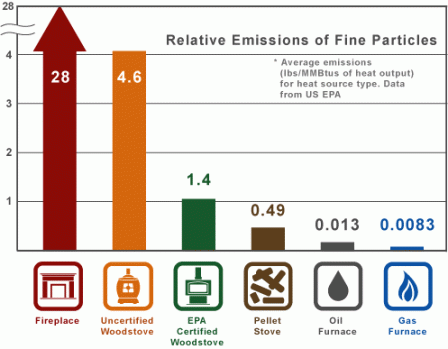Burn Wise Energy Efficiency
How Efficient is Your Appliance? The Right Wood Weatherization
Wood heaters manufactured before 1990 burn wood less efficiently-- wasting fuel, polluting your outdoor air and creating dust in your home. Replacing an old wood heater or fireplace with a more energy efficient appliance can save fuel, money, and protect you and your family's health. Many cleaner, energy saving options are certified by the EPA. In general, the lower the emissions, the higher the efficiency.
How Efficient is Your Wood-Burning Appliance?
Make sure your wood heater is an EPA-certified appliance. To identify an EPA-certified appliance, look on the back for a metal tag, refer to your owner's manual or check the list of appliances. Heaters with solid doors are generally older and should be replaced and disposed of properly. To learn more, visit how to choose an appliance.
tag, refer to your owner's manual or check the list of appliances. Heaters with solid doors are generally older and should be replaced and disposed of properly. To learn more, visit how to choose an appliance.
New wood-burning appliances:
- Are up to 50% more energy efficient.
- Save money, time and resources.
- Can use 1/3 less wood fuel for the same heat.
- Cut creosote build-up, reducing the risk of chimney fires.
Environmental benefits:
- Reduce indoor and outdoor wood smoke pollution, including carbon dioxide (CO2), methane (CH4) and black carbon (particle pollution).
- Save billions in health benefits each year linked to cancer, asthma and other serious conditions and health effects.
FIREPLACES: Generally, a wood-burning fireplace is an inefficient way to heat your home. Fireplace drafts can pull the warm air up the chimney, causing other rooms to be cooler. If you use central heat while burning in a fireplace, your heater will work harder to maintain constant temperatures throughout the house. Also, fireplaces do not burn as cleanly as EPA-certified wood heaters, creating 20 times the amount of air pollution.
For more efficient heating with less smoke, ask your local retailer about gas, pellet, or EPA-certified wood fireplace inserts. You can also add gas log lighter kits to your existing fireplace. These devices make it easier to light a wood fire and provide more efficient start up. EPA is also working with manufacturers to bring cleaner burning fireplaces to the market through the voluntary fireplace program.
A newer, properly installed wood heater produces a hotter fire, which requires less fuel and releases little smoke.
If you burn firewood, make sure it is dry, or “seasoned.” Wet wood can create excessive smoke. Moisture meters allow you to test the moisture level in wood, and can be bought at hardware stores or on the internet. Properly dried wood should have a reading of 20% or less.
- Split wood into pieces 6 inches in diameter or smaller for faster drying.
- Stack off the ground, split side down.
- Cover stack to protect the wood from rain and snow.
- Store for at least 6 months for softwood, and at least 12 months for hardwood.
Choose your firewood wisely. Hard wood tends to have the most energy per cord.
If you smell smoke in your home or see smoke coming out of the chimney, you may be burning wood that is too wet or have a problem with your stove or fireplace. If the problem persists after burning dry wood and opening the damper to get a full fire going, contact your local CSIA or NFI-certified professional for an inspection.
If you burn wood pellets, choose only pellets certified by the Pellet Fuels Institute (PFI) and always keep your pellet heater clean and well maintained.
Sealing and insulating cracks and crevices in your home can help improve indoor temperatures and save energy. However, don’t avoid the monster in the room- an old wood stove or fireplace. A more energy efficient stove will provide more heat while using less fuel.
If you qualify for heating assistance, you may also qualify to have your wood heater and chimney cleaned and/or repaired or replaced by your local heating assistance office.
